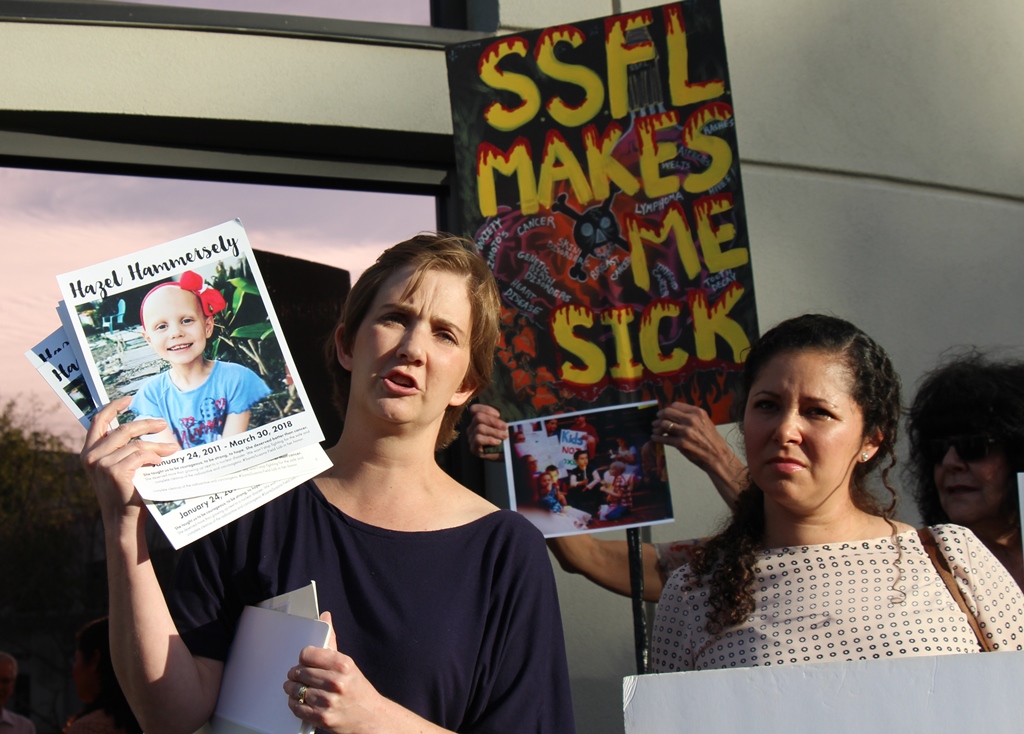
State toxics department deceives grieving community as it derails Santa Susana Field Laboratory cleanup, even as more radiation found
Nearly two dozen protesters demanding a promised comprehensive cleanup of the Santa Susana Field Laboratory (SSFL) picketed a Department of Toxic Substances Control (DTSC) bi-annual meeting in Chatsworth April 10. They included Melissa Bumstead, left, and Martha Martinez-Bravo in the above photo.
The activists included mothers of children suffering from rare cancers that they believe are linked to SSFL’s radioactive and chemical contamination. One of those children, seven year old Hazel Hammersley, had succumbed to neuroblastoma just weeks earlier, on March 30.
Protest signs reflected the anger of the community. One read “DTSC – Keep Your Word CLEAN UP ALL SSFL CONTAMINATION.” Another read “DTSC Greenwashers PROTECT KIDS’ HEALTH & NOT BOEING’S Wallet.”
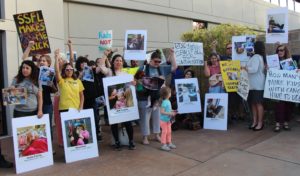
Longtime Rocketdyne activist “Wild Bill” Bowling of the Radiation Rangers held a “Kids NOT Toxins!” placard next to a “HOW MANY MORE KIDS WITH CANCER HAVE TO DIE” sign in the hands of Dawn Kowalski who has fought for cleaning up SSFL since 1989 and helped found the Rocketdyne Cleanup Coalition (RCC).
“Losing Hazel has been devastating to us, but her mother wants us to use her passing to push even harder for this cleanup,” said Melissa Bumstead to the protesters who gripped grim photos of children suffering from extremely rare cancers who live in the SSFL region, like Bumstead’s own daughter Grace Ellen. Bumstead is the founder of Parents vs SSFL.
“Tonight is in honor of Hazel, who touched thousands of lives. She was kind, funny and compassionate,” said Bumstead. “No parent should ever have to pray for a quick passing. That should never be the miracle.”
Once inside the sweltering auditorium, nearly 200 attendees were treated to cramped displays elbowed into crowded aisles. (This reporter managed to flag a friendly security guard who turned the air conditioning on as a 91 year old senior in a wheelchair was about to pass out.) Only 30 minutes were allowed for the public to voice their concerns, even though DTSC holds community SSFL meetings just twice a year.
Offsite Contamination in Plain Sight
One DTSC Offsite Investigations Overview handout claimed, “To date, DTSC has not found any evidence that contamination from research and testing operations at SSFL has posed or would pose a threat to human health or the environment outside the SSFL site boundaries.”
DTSC hasn’t “found” any evidence because it hasn’t looked for it even when the evidence is in the reports that it has released and should have read, and that are exposed in the media as in EnviroReporter.com‘s Brandeis Bardin’s Toxic Denial in 2017.
That exposé showed that a Department of Energy (DOE) report released by DTSC in early 2016 found a well on the Jewish camp in eastern Simi Valley contaminated with “Cadmium-113m neutron activation of Cadmium-112 used in reactor control rods” at an astounding 9,700 picocuries per liter (pCi/L). Another Brandeis-Bardin well was found to have “Tin-126 [which] is a fission product and is possibly [SSFL] site process related.”
By denying that any offsite SSFL contamination exists, DTSC excludes Brandeis-Bardin from remediation of its impacted property, not that the owners of the camp, American Jewish University (AJU), are in any hurry to address these shocking radiation finds. AJU has never issued any comment or statement about these SSFL-impacted wells down in the bottom of Meier Canyon and within easy reach of unsuspecting hikers. The last confirmed sighting of one oozing Brandeis-Bardin well was in early 2014.
The DTSC presentation included a map showing seven offsite drainages into Brandeis-Bardin, six of them emanating from nuclear experiments Area IV, yet made no note of the Jewish camp’s radiation-impacted wells caused by the Department of Energy. DOE and its predecessor’s scandalous litany of open-air radiation incineration, radioactive waste dumping and partial nuclear reactor meltdowns get a free pass by DTSC declaring no offsite toxin migration. Brandeis-Bardin gets the short shrift by DTSC.
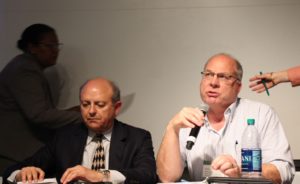
“Santa Susana contaminants have not migrated offsite at levels that threaten human health,” said SSFL program manager Mark Malinowski to the audience. The DTSC official apparently forgot that there is no ‘safe’ level for the “fission product” and isotope related to the “reactor control rods” found in the offsite Brandeis-Bardin wells.
“A preponderance of scientific evidence shows that even low doses of ionizing radiation, such as gamma rays and X-rays, are likely to pose some risk of adverse health effects, says a new report from the National Academies’ National Research Council,” the National Academy of Sciences stated in 2005. “In living organisms, such radiation can cause DNA damage that eventually leads to cancers.”
Malinowski did offer up one tidbit of cleanup progress, however ridiculous sounding. Since November 2017, DOE has started up “Groundwater Interim Measures” that consist of a “single, low flow well” that filters all of five gallons a week.
DTSC’s charade even included a clumsy attempt to rewrite history in the meeting handout. “Ahmanson Ranch – Environmental Sampling Report prepared 2000, concludes contamination did not migrate from SSFL,” the handout read. “CA Public Works Board in 2003 acknowledged conclusion satisfies due diligence standard for purchasing the property for use as parkland. Now part of Santa Monica Mountains Conservancy.”
Actually, Ahmanson Ranch groundwater tested positive for the SSFL-related rocket fuel oxidizer perchlorate in 2002 after this reporter’s questioning of the use of this possibly tainted water in an approved Washington Mutual development of 3,050 luxury homes bordering SSFl. DTSC should have known this for the last sixteen years since it was widely reported.
“The rocket fuel oxidizer, perchlorate, was found to be 14 times over what California currently considers safe for drinking water,” said 2002’s Ventura County Reporter cover story Rocketdyne Ranch. “One well tested positive for perchlorate at a level of 28 parts per billion (ppb).”
The ‘WaMu’ development was scuttled the next year as more contamination revelations piled up. Yet DTSC can’t even get this well-known history of the area right and displays it in public in an effort to maintain the myth that no SSFL goo has gotten offsite.
Revealing Reports
Reports released by DTSC just after the public meeting reveal that the department failed to inform the public about even more contamination found onsite at the former Rocketdyne outdoor testing range. One such document arrived in a May 14 DTSC email that included previously unpublished DTSC comments on Boeing’s reports on Subarea 5/9 South.
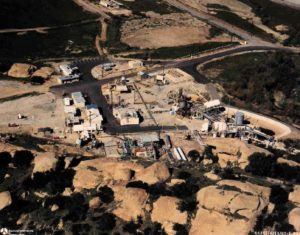
EnviroReporter.com had already reported in 2009 about intense chemical contamination in Boeing-controlled Area III of the lab which included the Space Technology Laboratory IV (STL-IV), the Environmental Effects Laboratory (EEL) and the Area III Sewage Treatment Plant (STP-3).
The known Area III chemical stew includes monomethyl hydrazine, methylene chloride, sodium hydroxide, formaldehyde, nitric acid, sodium azide, dimethyl sulfoxide, hydrofluoric acid, hydrazine, TCA, TCE, and polycyclic aromatic hydrocarbons (PAHs).
The runoff from Area III makes its way through the tony neighborhood of Bell Canyon as it descends into the Los Angeles River where the watercourse is undergoing a $1.4 billion revitalization. Nothing in the LA River plan addresses the contamination at the SSFL headwaters of the polluted waterway which could lead to human contact through wading, kayaking and eating fish from the river.
The Subarea 5/9 South comments show that DTSC must have known before the public event April 10 that Area III shows signs of significant radioactive contamination even though the government and its contractors have claimed for decades that Area IV radiation didn’t migrate throughout SSFL. [EnviroReporter.com already showed in 2016 that Boeing has Area I radiation that is astronomical in spots and unremediated even though the company allows hikes through affected areas.]
Area III’s STP-3 reading for the radioisotope Europium-152 came it at 3.6 times its background threshold value (BTV). Strontium-90 (Sr-90) detected at the EEL was 3.5 times its BTV according to readings taken by Boeing subcontractors assessing the site. According to documentation obtained by EnviroReporter.com, the California Highway Patrol considers any material or situation over 3.0 times background to be the triggering level for a hazardous materials incident.
The most alarming radiation reading came in the area of the former Space Technology Laboratory IV. There, Sr-90 registered a sizzling 11.1 times its BTV, over three times the CHP Haz-Mat threshold. None of this was mentioned at the meeting once DTSC officials began the public portion of the evening.
A 2017 report published by Physicians for Social Responsibility-Los Angeles titled, Analysis of Boeing’s Risk Assessments of the Santa Susana Field Laboratory, found that these figures translated into extraordinarily high cancer risk. The report states that:
• An astonishing 96 people out of a 100 exposed, at the Systems Test Lab IV, would get a cancer from the contamination on site.
• Every third person exposed at the Environmental Effects Lab would get a cancer from the contamination on site.
• Every fifth person exposed at Happy Valley North would get a cancer from the contamination on site.
• Every tenth person exposed at Compound A site would get a cancer from the contamination on site.
We Know What’s There
At the April 10 meeting, DTSC struggled to convince the community why the bulk of SSFL’s cleanup had yet to begin when in 2010 DTSC promised full cleanup by 2017. “I know a lot of questions have come up about why we’ve taken so long, let’s get the dang thing cleaned up,” Malinowski said. “And yeah, we do, but we can’t do that until we have a good investigation to tell us where contaminants are and what has to be cleaned up.”
This bold assertion is contradicted by the facts. In addition to a $41.5 million study of Area IV completed in 2012 courtesy of President Obama’s initiative, exactly where and how much of the radionuclides and chemicals are in Area IV is well known. The work completed by DOE since 2010 was up on a meeting poster.
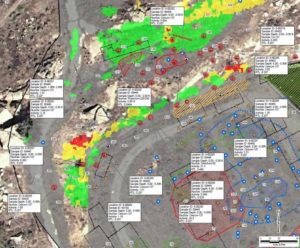
Over 3,600 radionuclide samples, 6,500 chemical samples and 100 soil vapor samples were taken resulting in comprehensive reports in 2012, 2015 and 2016. That was just in Area IV. Another meeting DTSC update showed that Boeing had completed its soil sampling field work after collecting over 7,500 soil samples and 650 soil vapor samples since 2012.
These impressive numbers, and their resultant reports, don’t even include the data generated by NASA in its responsibility to clean up its part of SSFL, including Area II. Malinowski feigning incomplete information as the reason for no cleanup was met with derisive hoots from the crowd.
“This is ridiculous,” said Marie Mason, longtime cleanup activist and co-founder of RCC, at a microphone for public comment. “We have to wait 17 more years? You know that what the hell’s on the ground in Area IV. You spent over $40 million. I’ve been at meetings. I’ve probably been to a thousand meetings in 30 years and you know what’s on the ground there so why are we still investigating? You’ve been investigating it forever. We know what’s there. Get DOE up there and tell them to start cleaning the crap out of there.”
Another RCC co-founder, Dawn Kowalski held up a photo of Hazel as she spoke. “All you’re doing is wasting our time,” said Kowalski. “And you’re wasting lives. That’s what’s the terrible thing. It’s tragic. And I think it’s criminal.”
Broken Promises
Further outraging the audience was the revelation that DTSC’s public participation supervisor Michelle Banks-Ordone, seated on stage next to Malinowski, had rejected 72,000 public comments on a petition demanding full cleanup of SSFL despite a personal pledge to a young cancer survivor who gave them to her in person. This elicited a rambling response mysterious in its meaning.
“In terms of the actual over 3,000 comments, those are individual comments received; that number doesn’t include the petition,” Banks-Ordone said to howls. “Those comments have been identified and we do have the comments for the petition. We, when we say how many comments we’ve received, those individual comments, separate and apart from the petition comments, so those numbers, and how many people actually signed that, that I don’t have for you tonight. I can give you the total number that we have in hand and I’ll be happy to reach out and give you that, but that just didn’t include those numbers.”
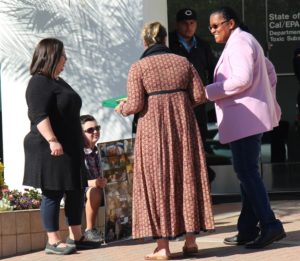
Indeed, this reporter and two others from the Los Angeles Daily News and CBS Los Angeles witnessed the brave child, and leukemia survivor, Ryan Compton deliver the comments to Banks-Odone at DTSC offices in Chatsworth, promising the boy that, of course, she would accept the petitions he gave her under the watchful eyes of his mother. Maggie Compton believes her son’s leukemia was a result of offsite SSFL toxins.
Not only is DTSC breaking its own promises, it appears to be letting SSFL polluters break their cleanup agreements as well. EnviroReporter.com found a little-noticed June 2017 NASA report called Human Health and Ecological Risk Assessments for NASA AIGs Santa Susana Field Laboratory in which the space agency reneges on its 2010 pledge to DTSC to remediate its polluted areas to background levels of contamination.
Instead of adhering to the signed cleanup agreements, NASA would use risk assessment based on recreational standards, which would leave almost all of the contamination in place. That isn’t good news for Brandeis-Bardin or future visitors to any Glow in the Dark Park that might open at SSFL before the new 2034 cleanup end time.
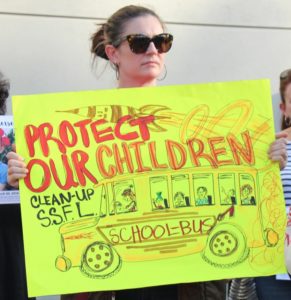
DTSC has previously said it would enforce the NASA and DOE cleanup agreements, but that seems unlikely given that its 2017 draft Environmental Impact Statement (EIS) sabotaged the entire cleanup and was panned by community members and elected officials. DTSC says it will release its final EIS this fall, followed by “decision documents” that will be open for public comment, representing the last opportunity the public will have to officially weigh in on the cleanup.
Some residents aren’t so sanguine about their prospects of ever seeing Rocketdyne cleaned up. They understandably think the endless delays and breaking of promises are by design.
“As I have watched the process over the years, the actions, not what is said, the actions tell me that DTSC is waiting for all interested parties, those of us who have an interest in the health of our communities and our families, until we’re dead and gone and then it can then just kind of be pushed to the side and not dealt with or not dealt with entirely,” said resident Robin Gilbert in public comment. “I hope DTSC can prove me wrong.”
25 Years of Award-Winning SSFL/Rocketdyne Reporting
1998 – 2023


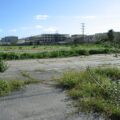









Chris Richards, one of the leading radio journalists who has extensively covered SSFL, reports for San Francisco’s KQED about the protest October 3 in front of California gubernatorial front runner Lt. Gov. Gavin Newsom’s campaign office in Los Angeles for the safe and complete cleanup of the Santa Susana Field Lab. Richards’ segment begins at 3:38 and includes this amazing news that ought to stir consternation for the tiny knot of pro-polluter “greenwashers” who have been fighting the cleanup using polluter money:
“Lt. Governor Newsom is committed to understanding more about the complexities around Santa Susana and the long-standing issues there, and charting a path – in partnership with the community – to clean up the site without further and unnecessary delays,” said the statement.
Things may be changing up on The Hill soon enough should Newsom win the governor’s race. Cleanup proponents EnviroReporter.com has heard from are now voting for Newsom and telling their friends and neighbors about Newsom’s bold stand on finally remediating the astronomically contaminated Santa Susana Field Laboratory.
It’s been TWENTY years that this has been going on. Boeing will never pay, now that they’ve captured the DTSC. And the toxics will never go away unless they’re physically removed. It’s time to slash defense spending — get Boeing where it hurts.
You can still sign our petition at http://www.change.org/santasusana to demand the complete cleanup.
@Dale: That “sufficient awareness” of risk is as unlikely as the cleanup to background agreed to in 2010. The public’s right to comment on the SSFL cleanup has been slashed and will end soon, all by DTSC design. The pressure from the press has evaporated with newspapers abandoning the beat for lack of reporters. And that 10 years you cite is actually 17, as in 17 years before SSFL is supposedly cleaned up by 2034. These delays and schemes to leave most of the goo in place actually backfire on the greenwashers’ Glow in the Dark Park scheme because of how much contamination will be left in place.
I have little faith that DTSC will ever require that SSFL be cleaned up to background levels. I am hopeful that sufficient awareness will eventually be generated so that everyone down wind and down stream will know their personal risk level. As long as the public is allowed to comment and pressure is applied through the press, we may finally get some remediation. But, 10 years! That’s beyond a reasonable amount of time to begin remediation work. Thank you, Michael Collins, for staying with this story and keeping it alive. Let’s hope the title of this article does not come to pass before the responsible parties finally clean up SSFL.